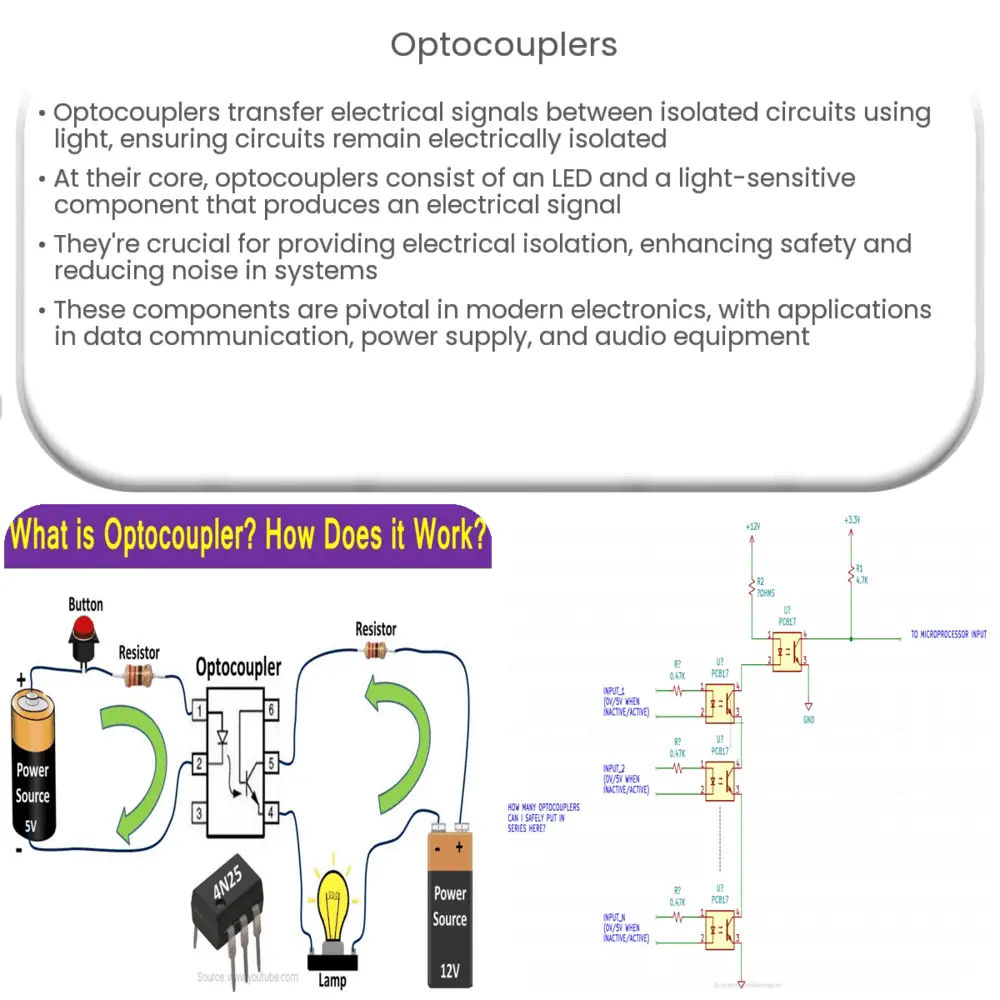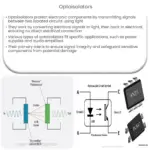Explore the workings of optocouplers, their structure, importance, applications, and types, and how they ensure safe electrical signal transfer.

Introduction to Optocouplers
An optocoupler, also known as an optoisolator or photocoupler, is an electronic component that transfers electrical signals between two isolated circuits by using light. This is a crucial device in the field of electronics because it enables communication between circuits that must remain electrically isolated from each other.
Basic Structure of Optocouplers
At the heart of an optocoupler, you’ll find a light source, typically an LED (Light Emitting Diode), and a light-sensitive component encapsulated in a small package. The light-sensitive component, often a phototransistor or a photodiode, reacts when it detects light from the LED, thereby creating an electrical signal.
- Light Emitting Diode (LED): This component emits light when current passes through it. The LED is placed in the input circuit.
- Phototransistor or Photodiode: These components respond to light rather than electric current. When the LED emits light, the phototransistor or photodiode detects it and generates a corresponding electrical signal. This component is situated in the output circuit.
Working Principle of Optocouplers
Despite their sophistication, the operational principle of optocouplers is relatively straightforward. The LED in the input circuit gets activated when a voltage is applied, causing it to emit light. This light is then detected by the phototransistor or photodiode in the output circuit. The amount of current generated by the phototransistor or photodiode is proportional to the light received. Therefore, the input signal is effectively transferred to the output side, but the two circuits remain electrically isolated.
Importance of Electrical Isolation
The key reason why optocouplers are used is to provide electrical isolation between the input and output circuits. There are several reasons why this is crucial:
- Safety: Optocouplers prevent high voltages from affecting the system receiving the signal. This is particularly important in situations where the input signal originates from a high voltage source, and the output side includes sensitive components, such as microprocessors.
- Noise Reduction: Optocouplers help to reduce electrical noise in systems. Noise can lead to false signals and interference, which can cause system malfunctions.
Common Applications of Optocouplers
Given their capabilities, optocouplers have a broad range of applications across various industries. Some common uses include:
- Data Communication: Optocouplers are used in data communication devices to enable safe data transfer between different systems while maintaining electrical isolation.
- Power Supply Devices: In power supply circuits, optocouplers help in voltage regulation by isolating the input and feedback circuits.
- Audio Equipment: In audio amplifier systems, optocouplers are used to eliminate electrical noise that could interfere with the sound quality.
Types of Optocouplers
There are several types of optocouplers, each with their unique properties and suited to different applications:
- Phototransistor Optocouplers: These are the most common type, used in many general-purpose applications.
- Photodarlington Optocouplers: These provide greater sensitivity than phototransistor optocouplers, but with a slower response time.
- Phototriac Optocouplers: These are primarily used in AC power control applications.
- High-Speed Optocouplers: As the name suggests, these are designed for high-speed data transmission applications.
Conclusion
In conclusion, optocouplers play a vital role in modern electronics, providing the ability to transfer electrical signals between isolated circuits safely and efficiently. By preventing high voltages from affecting sensitive components and reducing electrical noise, optocouplers help to ensure the smooth operation of electronic systems across a range of industries.
Whether it’s data communication, power supply, or audio equipment, optocouplers are at work, enabling reliable and safe operation. As technology continues to advance, the importance of these versatile components is set to grow even further.



